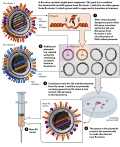Reverse genetics
Reverse genetics is a method used in molecular biology to help understand the function of genes by disrupting them through engineered mutations. The term "reverse genetics" is used to highlight the reverse direction to classical genetics methodology.
Overview[edit]
Classical genetics traditionally uses the phenotype to determine the genotype. In contrast, reverse genetics starts with the genotype before determining the phenotype. This method allows scientists to understand the role of specific genes in an organism's phenotype.
Methodology[edit]
The process of reverse genetics involves creating a mutation in a known gene to disrupt its function, which can then be compared to the normal phenotype. This is often achieved through techniques such as RNA interference (RNAi), CRISPR-Cas9, and homologous recombination.
RNA interference[edit]
RNA interference is a biological process where RNA molecules inhibit gene expression. This method is often used in reverse genetics to "knock down" a gene and observe the resulting phenotype.
CRISPR-Cas9[edit]
CRISPR-Cas9 is a revolutionary gene-editing system that allows scientists to edit parts of the genome by removing, adding, or altering sections of the DNA sequence. It is currently the simplest and most versatile tool for genetic manipulation, making it a popular choice in reverse genetics.
Homologous recombination[edit]
Homologous recombination is a type of genetic recombination where nucleotide sequences are exchanged between two similar or identical strands of DNA. It is used in reverse genetics to replace a normal gene with a mutated one.
Applications[edit]
Reverse genetics has a wide range of applications in various fields such as genetics, medicine, and agriculture. It is particularly useful in studying diseases, as it allows scientists to identify the specific genes associated with a disease and understand their function.
See also[edit]
References[edit]
<references group="" responsive="1"></references>

Reverse_genetics[edit]
-
Reverse Genetics Flu
-
Physcomitrella Knockout Mutants
Ad. Transform your life with W8MD's Budget GLP-1 injections from $75


W8MD offers a medical weight loss program to lose weight in Philadelphia. Our physician-supervised medical weight loss provides:
- Weight loss injections in NYC (generic and brand names):
- Zepbound / Mounjaro, Wegovy / Ozempic, Saxenda
- Most insurances accepted or discounted self-pay rates. We will obtain insurance prior authorizations if needed.
- Generic GLP1 weight loss injections from $75 for the starting dose.
- Also offer prescription weight loss medications including Phentermine, Qsymia, Diethylpropion, Contrave etc.
NYC weight loss doctor appointmentsNYC weight loss doctor appointments
Start your NYC weight loss journey today at our NYC medical weight loss and Philadelphia medical weight loss clinics.
- Call 718-946-5500 to lose weight in NYC or for medical weight loss in Philadelphia 215-676-2334.
- Tags:NYC medical weight loss, Philadelphia lose weight Zepbound NYC, Budget GLP1 weight loss injections, Wegovy Philadelphia, Wegovy NYC, Philadelphia medical weight loss, Brookly weight loss and Wegovy NYC
|
WikiMD's Wellness Encyclopedia |
| Let Food Be Thy Medicine Medicine Thy Food - Hippocrates |
Medical Disclaimer: WikiMD is not a substitute for professional medical advice. The information on WikiMD is provided as an information resource only, may be incorrect, outdated or misleading, and is not to be used or relied on for any diagnostic or treatment purposes. Please consult your health care provider before making any healthcare decisions or for guidance about a specific medical condition. WikiMD expressly disclaims responsibility, and shall have no liability, for any damages, loss, injury, or liability whatsoever suffered as a result of your reliance on the information contained in this site. By visiting this site you agree to the foregoing terms and conditions, which may from time to time be changed or supplemented by WikiMD. If you do not agree to the foregoing terms and conditions, you should not enter or use this site. See full disclaimer.
Credits:Most images are courtesy of Wikimedia commons, and templates, categories Wikipedia, licensed under CC BY SA or similar.
Translate this page: - East Asian
中文,
日本,
한국어,
South Asian
हिन्दी,
தமிழ்,
తెలుగు,
Urdu,
ಕನ್ನಡ,
Southeast Asian
Indonesian,
Vietnamese,
Thai,
မြန်မာဘာသာ,
বাংলা
European
español,
Deutsch,
français,
Greek,
português do Brasil,
polski,
română,
русский,
Nederlands,
norsk,
svenska,
suomi,
Italian
Middle Eastern & African
عربى,
Turkish,
Persian,
Hebrew,
Afrikaans,
isiZulu,
Kiswahili,
Other
Bulgarian,
Hungarian,
Czech,
Swedish,
മലയാളം,
मराठी,
ਪੰਜਾਬੀ,
ગુજરાતી,
Portuguese,
Ukrainian



